Reverse Sear Steak with Garlic and Thyme
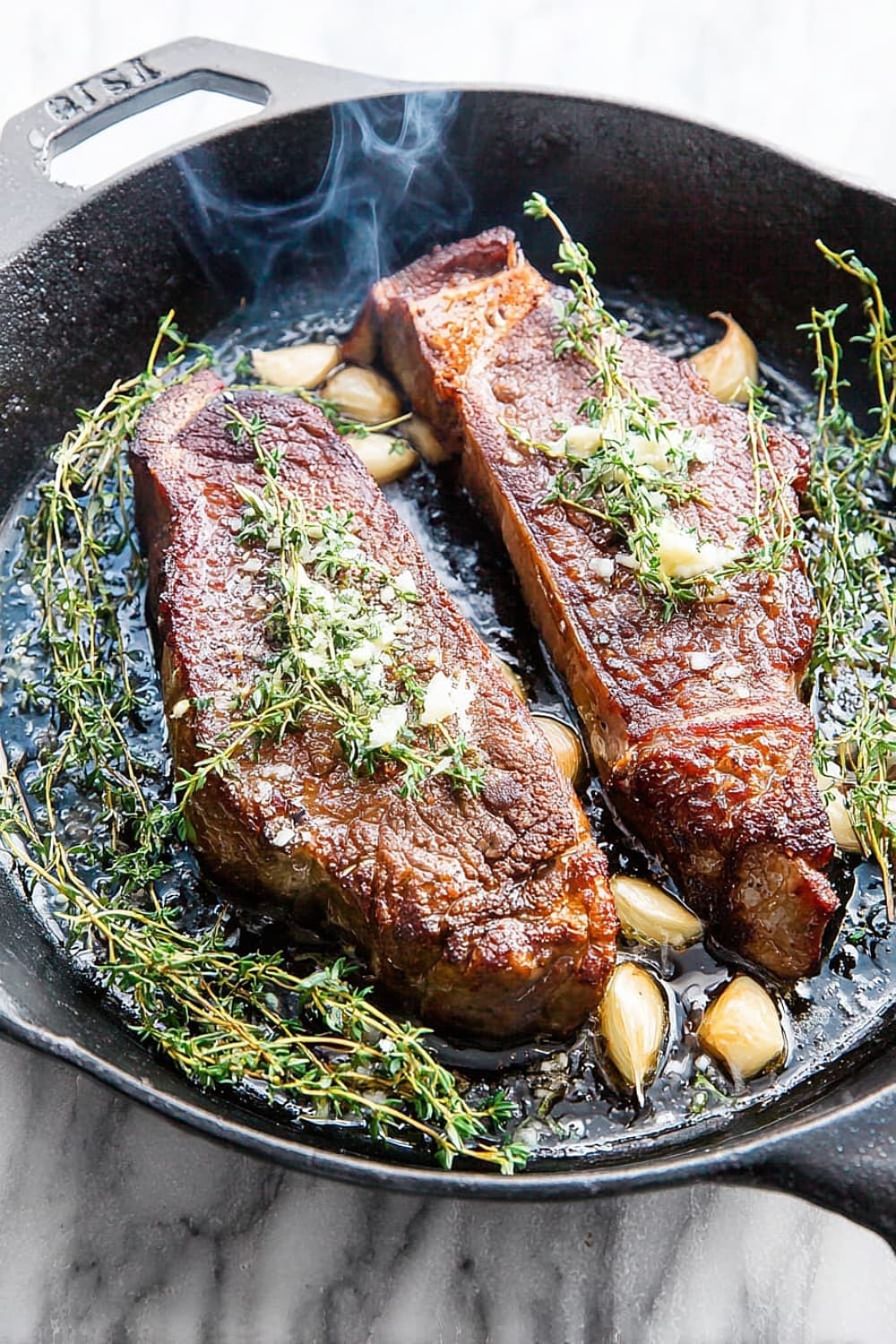
This is the kind of steak technique that makes you look like a culinary genius when really you just followed some very smart science.
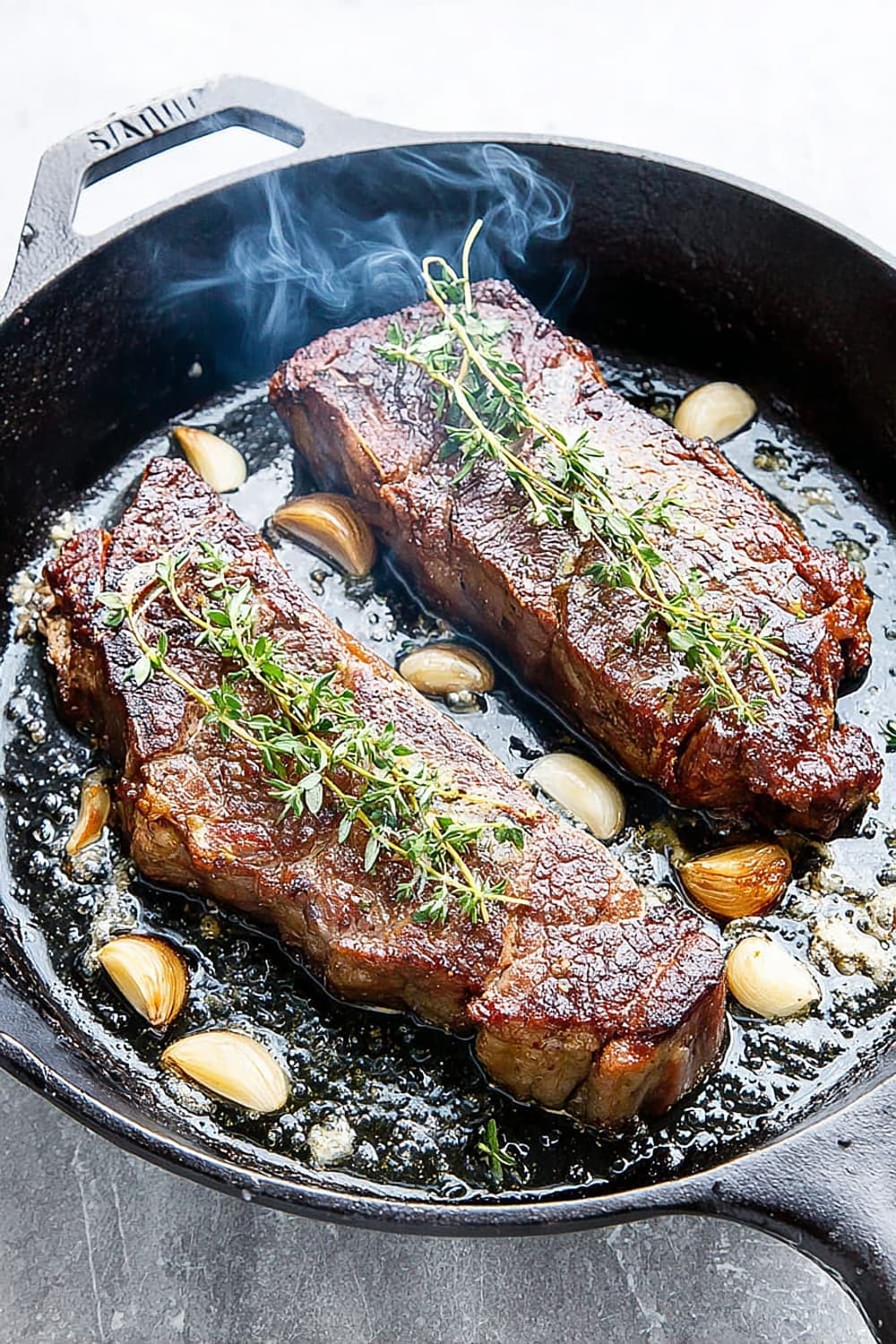
The reverse-sear method flips traditional steak cooking on its head, starting low and slow in the oven before finishing with a blazing hot sear that creates the most incredible crust.
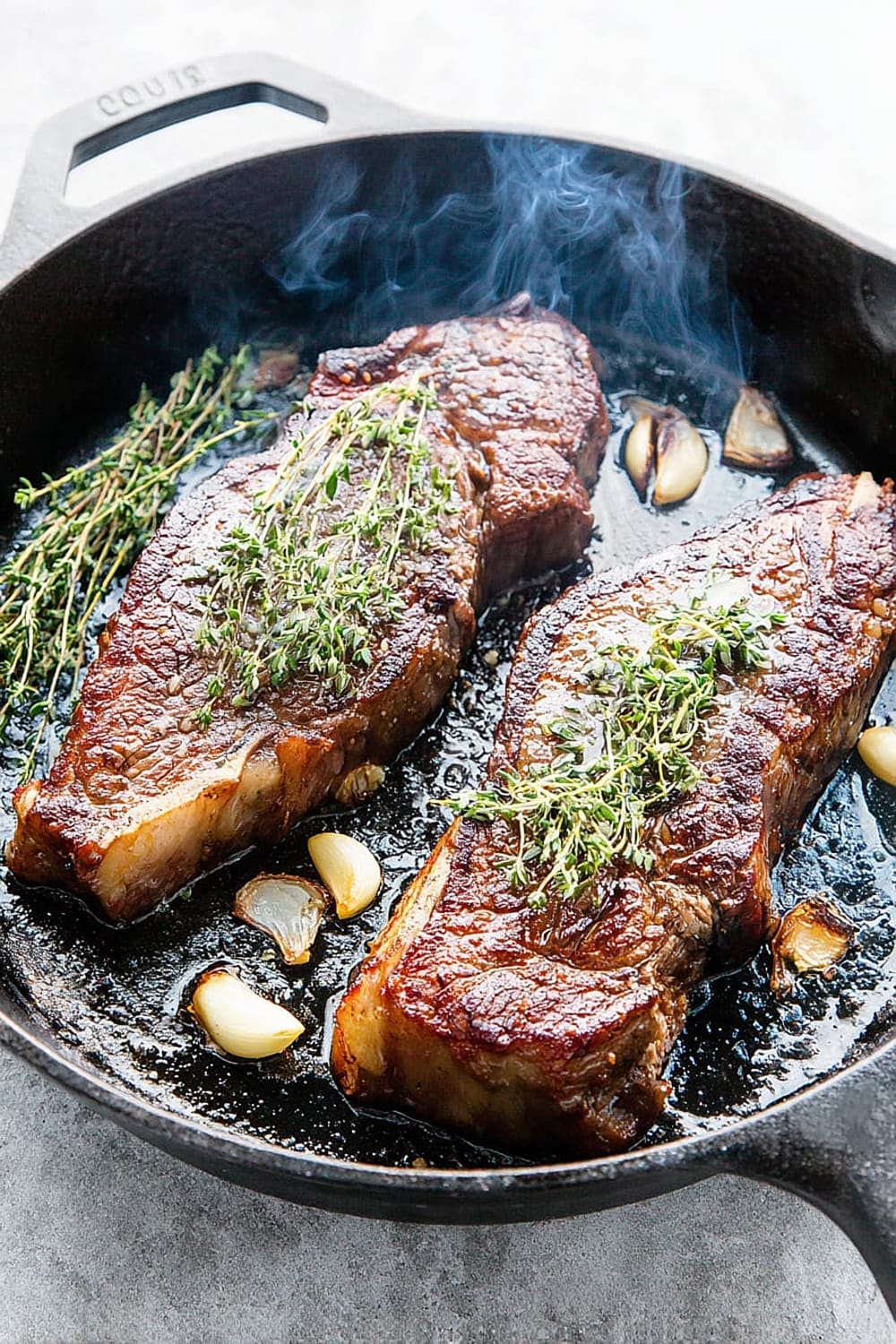
What you get is restaurant-quality steak with edge-to-edge perfect doneness and zero guesswork about whether you’ve nailed that perfect medium-rare.
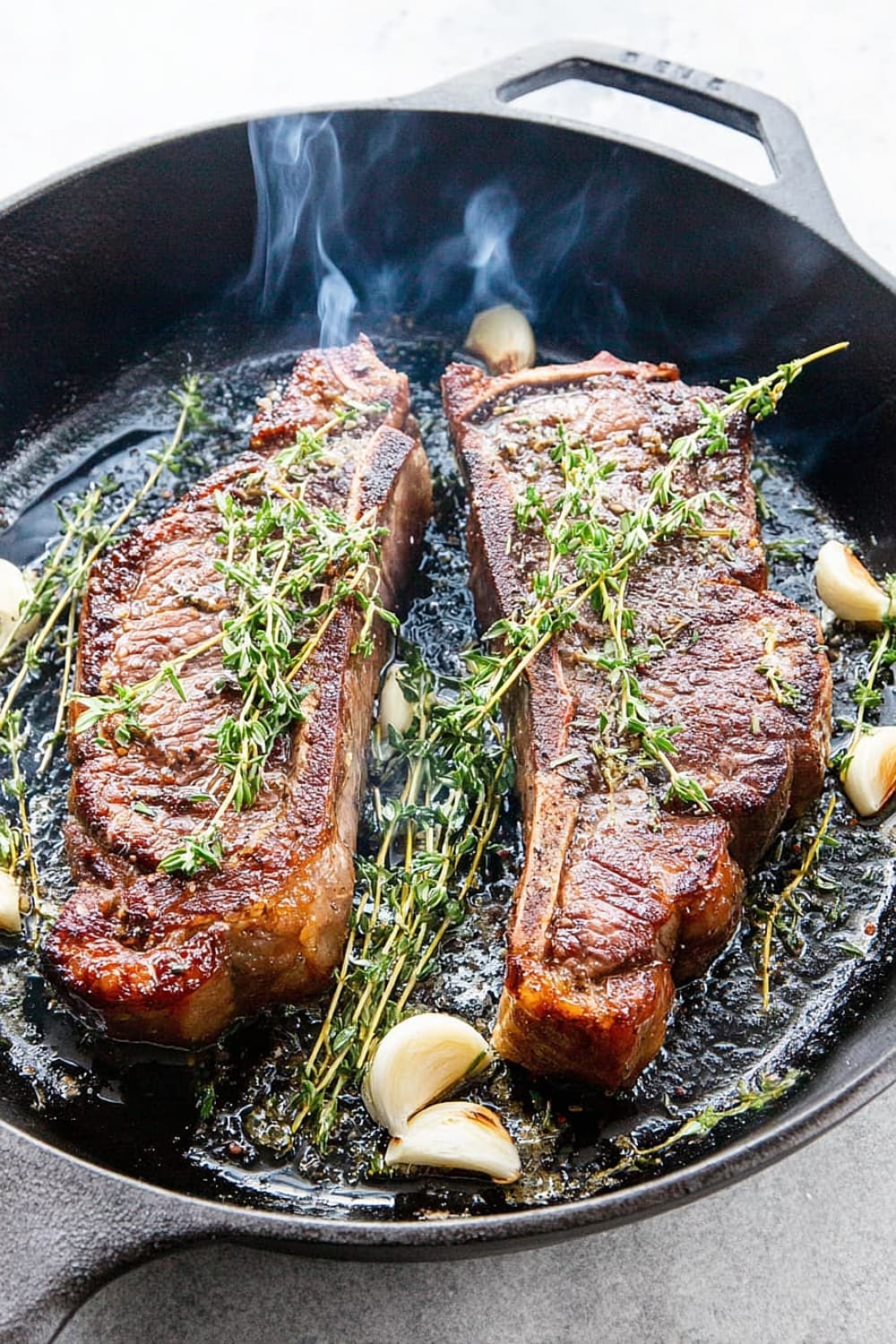
The gentle oven cooking ensures your steak reaches the exact internal temperature you want, while that final cast iron skillet sear creates a caramelized crust that’ll make your taste buds do a happy dance.
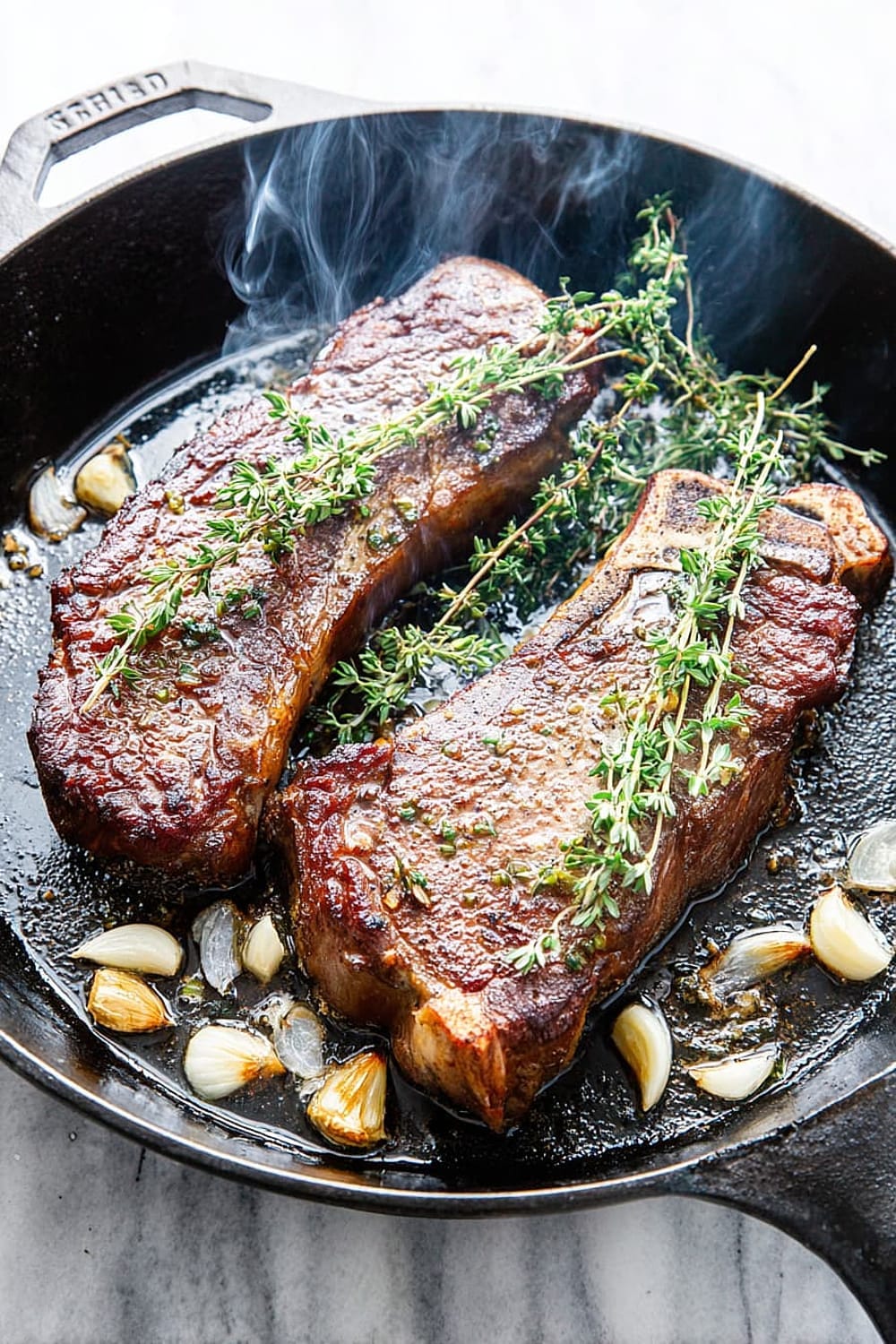
Fresh thyme and garlic cloves added during the searing process infuse the steak with aromatic herbs that smell absolutely incredible and taste even better.

This technique works brilliantly for thick steaks and practically guarantees you’ll never serve an overcooked or unevenly cooked steak again.
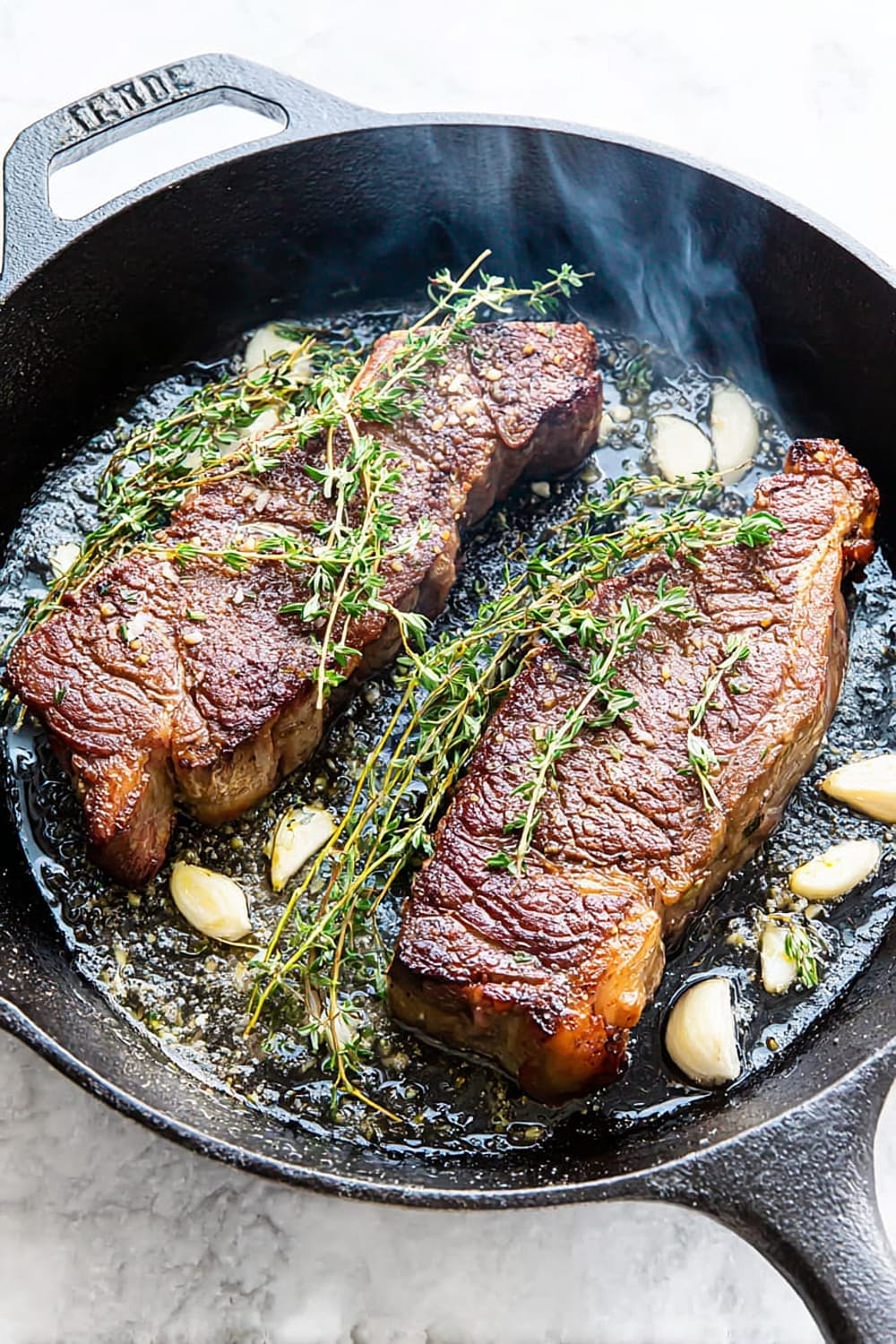
Ingredients
For the Steaks
- 2 (12-ounce) steaks, about 1-inch thick (ribeye, strip, or filet mignon work beautifully)
- Salt and freshly ground black pepper for generous seasoning
- 2-3 tablespoons vegetable oil (or any high-heat cooking oil)
For Aromatic Finishing
- Fresh thyme sprigs (optional but highly recommended)
- Garlic cloves, peeled (optional but adds incredible flavor)
Instructions
Preparation
- 1 Preheat your oven to 200°F (93°C). This low temperature is key to the reverse-sear method’s success.
- 2 Line a baking sheet with aluminum foil and spray an oven-safe baking rack with cooking spray. Place the rack inside the baking sheet. This setup allows air circulation around the steaks for even cooking.
- 3 Generously season both sides of steaks with salt and pepper. Don’t be shy here – the seasoning creates flavor and helps develop that beautiful crust later. Place seasoned steaks on the prepared baking rack.
- 4 Insert a probe thermometer into the thickest part of the largest steak, making sure the tip isn’t touching any bones or large chunks of fat. This ensures accurate temperature readings for perfect doneness.
Slow Oven Cooking
- 5 Bake until steaks reach your desired internal temperature. Set the temperature alert on your instant-read thermometer to 115-118°F (46-48°C) for medium doneness, or 108-110°F (42-43°C) for medium-rare. This process will take approximately 45 minutes to 1 hour, depending on steak thickness.
Preparing for the Sear
- 6 When steaks have a few degrees left to reach target temperature, start preheating a large, heavy cast iron skillet over medium-high heat. The cast iron skillet needs about 5-10 minutes to thoroughly preheat, while thinner skillets require less time.
- 7 Test that your pan is properly heated – a drop of water should violently sizzle and almost instantly disappear. This indicates the perfect searing temperature.
- 8 Add vegetable oil to the skillet and heat until smoking. The oil should shimmer and just begin to smoke, indicating it’s hot enough for a proper sear.
The Final Sear
- 9 Using tongs, carefully transfer steaks (remove the probe thermometer first) to the hot skillet, being cautious of oil splattering. Sear for 60 seconds, then flip and cook for another 60-80 seconds.
- 10 Once you flip the steaks, add fresh thyme and peeled garlic cloves for extra flavor and aromatic appeal. The herbs will sizzle and release incredible fragrance.
- 11 If cooking more than 2 steaks, sear them in batches of 2 to avoid overcrowding the pan. Let the skillet reheat completely between batches for consistent results.
- 12 Remove steaks from skillet and transfer to a cutting surface. Slice across the grain and serve immediately while still warm for the best texture and flavor.
Recommended Equipment and Kitchen Tools
Essential Tools (for best results)
- Cast iron skillet – Superior heat retention creates the perfect sear and develops incredible crust formation
- Instant-read or probe thermometer – Takes guesswork out of achieving perfect doneness every time
- Oven-safe wire rack – Allows air circulation for even cooking and prevents steaks from sitting in juices
- Heavy-duty tongs – Essential for safely handling steaks during the high-heat searing process
Helpful Upgrades
- Digital kitchen scale – Ensures consistent steak portions and helps calculate cooking times more accurately
- Silicone-tipped tongs – Won’t scratch your cast iron skillet while providing excellent grip on steaks
- Aluminum foil – Makes cleanup easier and protects your baking sheet from drippings
Nice-to-Have Options
- Bench scraper – Perfect for transferring sliced steak from cutting board to serving plates
- Quality cutting board – A large wooden or bamboo board provides ample space for slicing steaks properly
Recipe Variations and Dietary Modifications
Seasoning Variations
- Montreal steak seasoning → Replace salt and pepper with 2-3 tablespoons Montreal seasoning for bold flavor
- Herb crust → Mix 2 tablespoons chopped fresh rosemary, thyme, and oregano with salt and pepper
- Cajun-style → Use 2 tablespoons Cajun seasoning blend for spicy, smoky flavor
- Coffee rub → Combine 1 tablespoon ground coffee with salt, pepper, and brown sugar
Oil Alternatives
- Avocado oil → Higher smoke point than vegetable oil, perfect for high-heat searing
- Grapeseed oil → Neutral flavor with excellent high-temperature performance
- Ghee or clarified butter → Adds rich, nutty flavor without burning at high temperatures
Herb and Aromatics Options
- Rosemary and sage → Mediterranean-inspired flavor profile with earthy notes
- Oregano and lemon zest → Bright, fresh finish that complements beef beautifully
- Shallots and bay leaves → French-inspired aromatic combination for elegant presentation
Steak Cut Adaptations
- Thicker cuts (1.5-2 inches) → Increase oven time to 60-90 minutes for proper heat penetration
- Thinner cuts (3/4 inch) → Reduce oven time to 30-40 minutes to prevent overcooking
Nutritional Information and Health Benefits
Key Nutritional Highlights
Each serving provides approximately 450-500 calories with 35-40 grams of high-quality complete protein. The reverse-sear method requires minimal added fats, keeping the dish relatively lean while maximizing flavor. Beef provides essential B-vitamins, particularly B12, niacin, and riboflavin, along with significant amounts of zinc, selenium, and iron.
Health Benefits of Main Ingredients
Grass-fed beef contains higher levels of omega-3 fatty acids and conjugated linoleic acid (CLA) compared to grain-fed alternatives. Fresh thyme provides antioxidants including thymol and carvacrol, which have antimicrobial properties. Garlic contains allicin, a compound with potential cardiovascular benefits and immune system support. The minimal oil usage keeps saturated fat content reasonable while providing essential fatty acids.
Dietary Considerations
This recipe is naturally gluten-free, dairy-free, and keto-friendly. It’s high in protein and virtually carb-free, making it suitable for low-carb and paleo dietary patterns. The cooking method preserves nutrients better than high-heat cooking throughout, reducing the formation of potentially harmful compounds while maintaining beef’s nutritional integrity.
Smart Swaps and Ingredient Substitutions
Steak Cut Substitutions:
- Ribeye → Strip steak or filet mignon (adjust cooking time based on thickness)
- Expensive cuts → Top sirloin or flat iron steak for budget-friendly options
- Individual steaks → Thick pork chops using identical cooking method and temperatures
Oil Alternatives:
- Vegetable oil → Canola oil, avocado oil, or grapeseed oil in equal amounts
- High-heat oils → Coconut oil (refined) for dairy-free, paleo-friendly option
- Neutral oils → Light olive oil (not extra virgin) for subtle flavor enhancement
Seasoning Swaps:
- Fresh thyme → Dried thyme (1 teaspoon dried equals 1 tablespoon fresh)
- Fresh garlic → Garlic powder (1/2 teaspoon per clove) mixed into seasoning
- Black pepper → White pepper or cracked coriander for different flavor profiles
Pro Tips for Substitutions:
- Room temperature steaks cook more evenly – remove from refrigerator 30 minutes before cooking
- Kosher salt adheres better than table salt and provides superior seasoning distribution
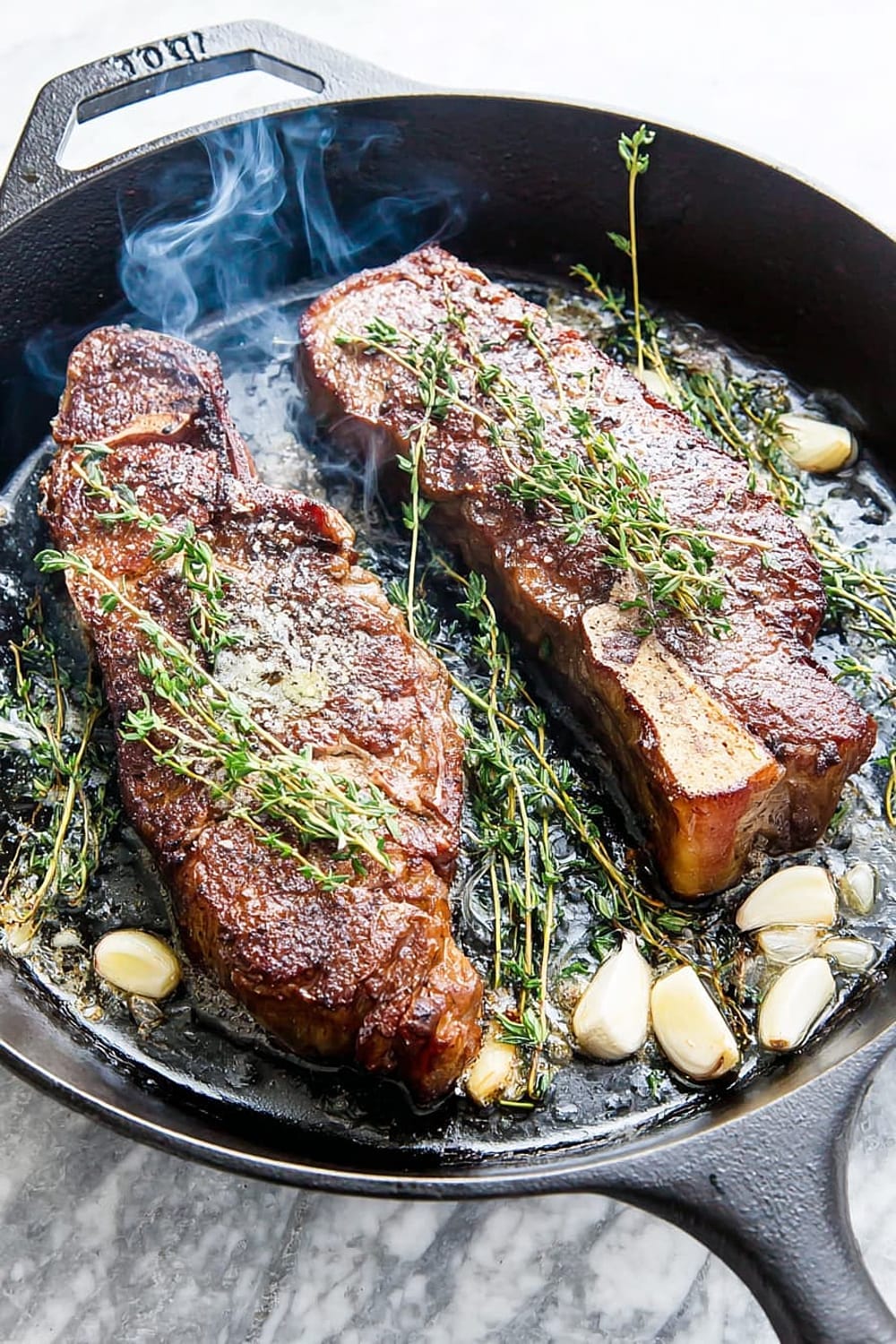
Make It Diabetes-Friendly
Carb Content Analysis:
- Total carbs per serving: Less than 1 gram (primarily from garlic and herbs)
- Net carbs: Essentially 0 grams making this extremely diabetes-friendly
- Glycemic impact: Virtually none due to absence of carbohydrates
Blood Sugar Management Tips:
- Pair with non-starchy vegetables like roasted broccoli, asparagus, or sautéed spinach
- Add healthy fats through avocado slices or mixed greens salad with olive oil dressing
- Portion control: 4-6 ounce serving provides satiety without excessive calories
Meal Timing Strategies:
- Post-workout meal – High protein content supports muscle recovery and stable blood sugar
- Dinner option – Low carb content won’t interfere with overnight blood sugar control
- Intermittent fasting friendly – Fits perfectly into low-carb eating windows
Enhanced Diabetes Benefits:
- High protein content helps maintain steady blood glucose levels
- Healthy fats from quality beef support hormone production and satiety
- Zero added sugars or processed ingredients eliminate blood sugar spikes
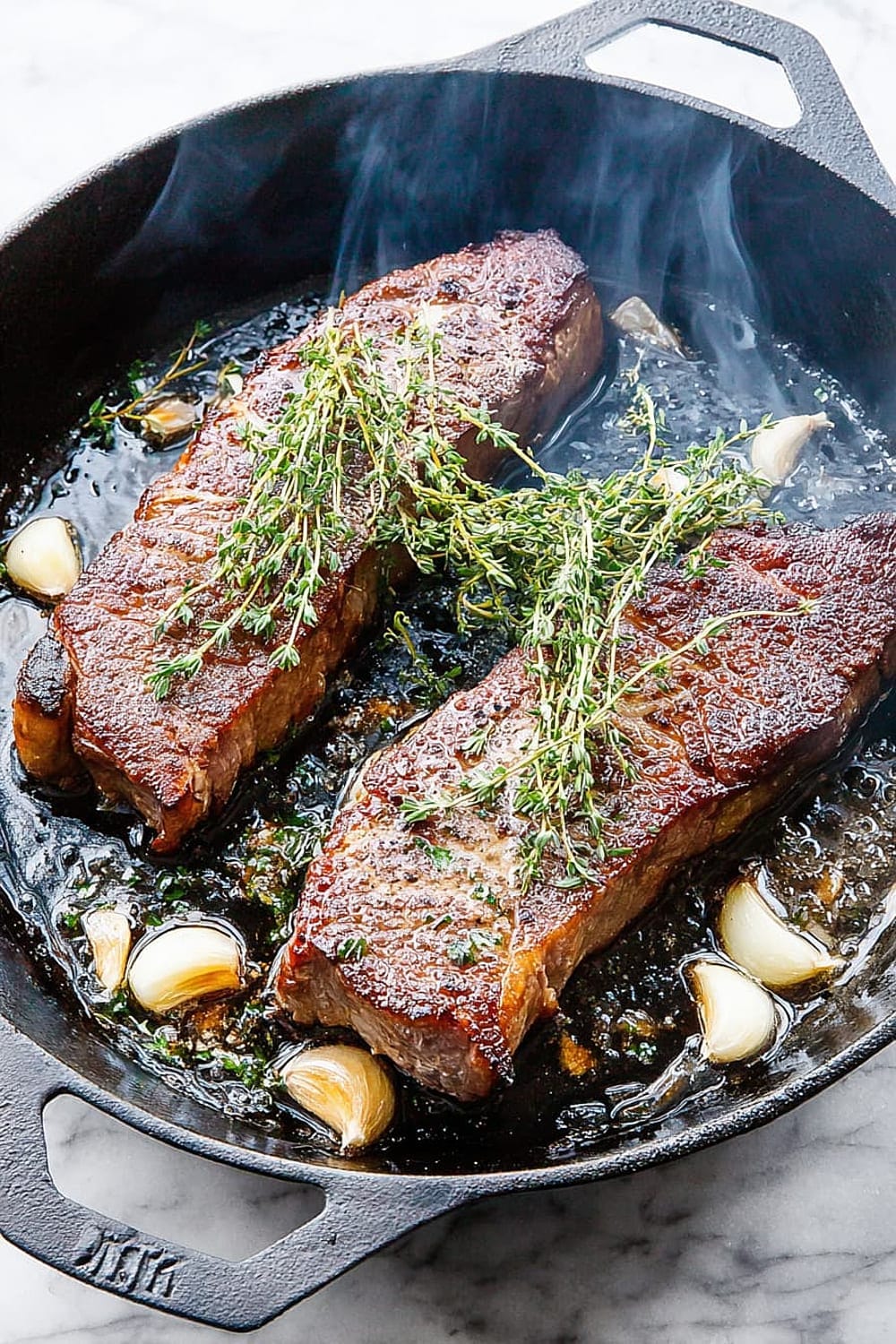
Perfect Pairing Suggestions
Beverage Pairings
Bold red wines like Cabernet Sauvignon, Malbec, or Syrah complement the rich, savory flavors beautifully. For beer lovers, dark stouts or robust porters provide excellent contrast to the meat’s richness. Non-alcoholic options include unsweetened iced tea with lemon, sparkling water with lime, or rich coffee for evening dining.
Side Dish Recommendations
Roasted vegetables like Brussels sprouts with bacon, honey-glazed carrots, or garlic roasted asparagus provide excellent textural contrast. Creamy mashed cauliflower or roasted sweet potatoes offer comfort food appeal without overwhelming the steak’s flavor. Fresh salads with arugula, cherry tomatoes, and balsamic vinaigrette add brightness and acidity that cuts through the meat’s richness.
Complete Meal Ideas
Start with bacon-wrapped scallops or stuffed mushrooms as appetizers. Include loaded baked potatoes or truffle mac and cheese for indulgent comfort food vibes. Chocolate lava cake or crème brûlée provides the perfect sweet ending to this sophisticated meal.
Occasion Suggestions
Perfect for romantic dinners, special celebrations, or weekend entertaining when you want to impress without stress. The make-ahead friendly nature makes it ideal for dinner parties where you can focus on guests rather than constantly monitoring the stove.
Pro Tips and Troubleshooting
Professional Techniques
Salt steaks 40-60 minutes before cooking to allow proper seasoning penetration and surface moisture removal for better searing. Use a digital probe thermometer with alerts to prevent overcooking – the difference between perfect and overcooked is just a few degrees. Let the cast iron skillet preheat thoroughly – rushing this step results in uneven searing and poor crust development.
Common Mistakes to Avoid
Don’t skip the wire rack – steaks sitting directly on the pan will cook unevenly and steam rather than roast. Avoid opening the oven frequently as temperature fluctuations extend cooking time and affect results. Never press steaks with spatula during searing as this squeezes out precious juices and prevents proper crust formation.
Storage and Reheating
Refrigerate leftover steak up to 3 days wrapped tightly in plastic wrap. Reheat gently in 250°F (121°C) oven until warmed through, about 10-15 minutes. Slice cold steak thinly for salads or sandwiches to maximize tenderness.
Make-Ahead Strategies
Season steaks up to 24 hours ahead and refrigerate uncovered for enhanced flavor and better searing. Complete oven cooking earlier in the day and sear just before serving for stress-free entertaining.
The reverse-sear method transforms steak cooking from guesswork into foolproof science, delivering restaurant-quality results every single time. Master this technique once, and you’ll never go back to traditional steak cooking methods that leave you wondering if you’ve hit the perfect doneness.